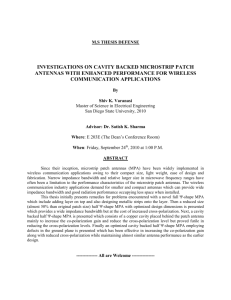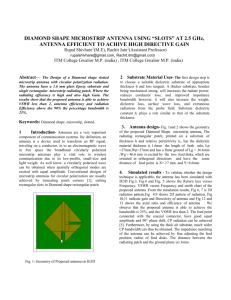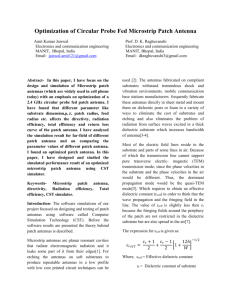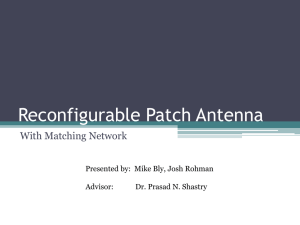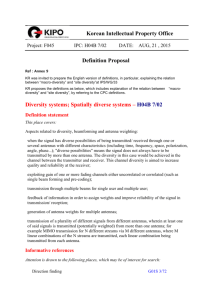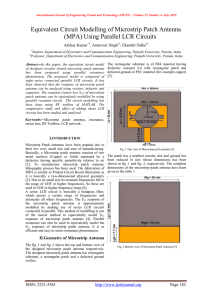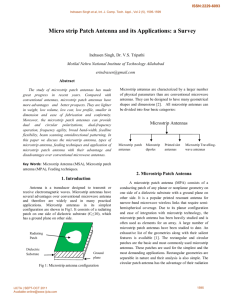F#N6M
advertisement
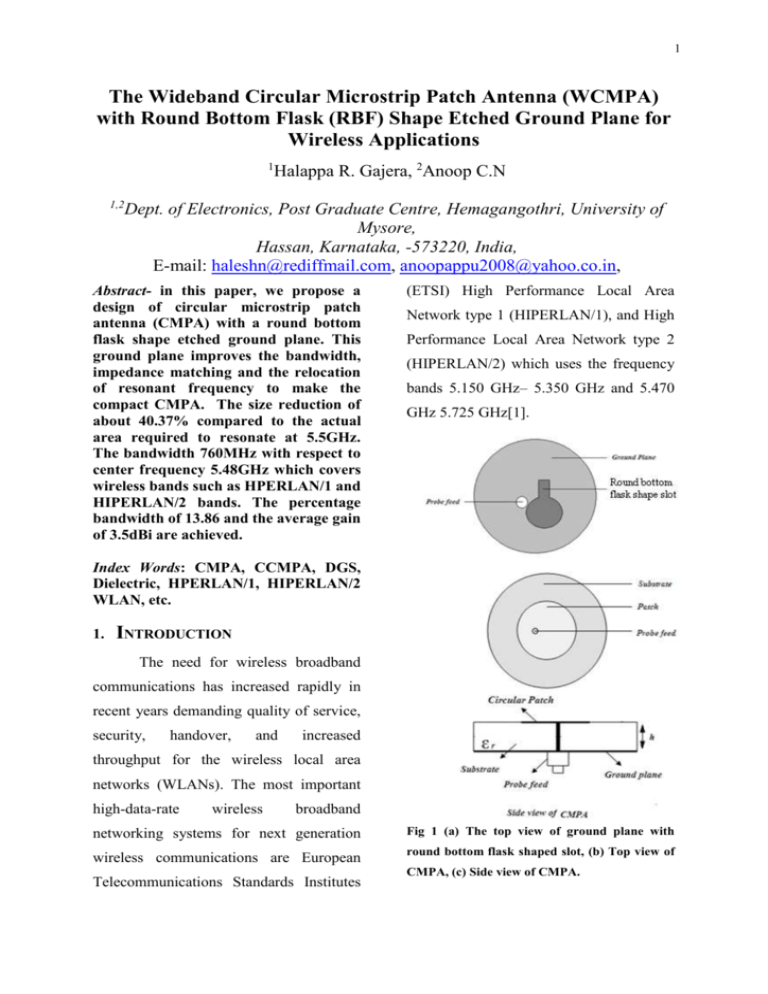
1 The Wideband Circular Microstrip Patch Antenna (WCMPA) with Round Bottom Flask (RBF) Shape Etched Ground Plane for Wireless Applications 1 1,2 Halappa R. Gajera, 2Anoop C.N Dept. of Electronics, Post Graduate Centre, Hemagangothri, University of Mysore, Hassan, Karnataka, -573220, India, E-mail: haleshn@rediffmail.com, anoopappu2008@yahoo.co.in, Abstract- in this paper, we propose a design of circular microstrip patch antenna (CMPA) with a round bottom flask shape etched ground plane. This ground plane improves the bandwidth, impedance matching and the relocation of resonant frequency to make the compact CMPA. The size reduction of about 40.37% compared to the actual area required to resonate at 5.5GHz. The bandwidth 760MHz with respect to center frequency 5.48GHz which covers wireless bands such as HPERLAN/1 and HIPERLAN/2 bands. The percentage bandwidth of 13.86 and the average gain of 3.5dBi are achieved. (ETSI) High Performance Local Area Network type 1 (HIPERLAN/1), and High Performance Local Area Network type 2 (HIPERLAN/2) which uses the frequency bands 5.150 GHz– 5.350 GHz and 5.470 GHz 5.725 GHz[1]. Index Words: CMPA, CCMPA, DGS, Dielectric, HPERLAN/1, HIPERLAN/2 WLAN, etc. 1. INTRODUCTION The need for wireless broadband communications has increased rapidly in recent years demanding quality of service, security, handover, and increased throughput for the wireless local area networks (WLANs). The most important high-data-rate wireless broadband networking systems for next generation Fig 1 (a) The top view of ground plane with wireless communications are European round bottom flask shaped slot, (b) Top view of Telecommunications Standards Institutes CMPA, (c) Side view of CMPA. 2 The modern wireless communication systems require the antennas for different systems and standards with characteristics like compact, broadband, multiple resonant frequencies and moderate gain. Because of many attractive features, microstrip patch antennas have attention for received wireless considerable communication applications [2–8]. Single layer microstrip antennas have very narrow bandwidth, but using two-layer proximity coupled microstrip antennas higher bandwidth can be achieved [9–13]. Since radiation pattern II. ANTENNA DESIGN The antenna is fabricated on the substrate FR4_epoxy with relative permittivity εr = 4.4 and the thickness of 3.2mm. The radius of the patch (a) and ground plane are calculated using the formulas given in [1], for the resonant frequency of 5.4GHz. The actual radius of patch as per formula is 7.12mm; we reduced the radius of the patch to 5.5mm so the size of the CMPA is reduced by 40.37% because of round bottom flask shape etched on the ground plane. of a microstrip antenna has wide beam width in one hemisphere, two back-to-back microstrip antennas in the same module can be used to produce nearly omni directional radiation pattern required for LAN applications [4, 12, and 13]. Compact circular microstrip patch antenna can be designed by embedding suitable slots on the radiating patch and by The effects of round bottom flask neck slot and base are studied separately by varying the parameters like length, width and radius. The effect of the thickness height also verified. All the dimensions of the optimized CMPA are tabulated in table 1. III. SIMULATED RESULTS The round bottom flask base radius using the defected ground plane as DGS is optimized to 2.5mm by varying the radius (r) from 1mm to 3mm, as it increases beyond 2.5mm then it reduces the gain and when it reduced less than 2.5mm then it shifts the resonant frequency to higher frequency as shown S11 in fig 3. Fig 2 Top view of ground plane 3 Case (iii) the round bottom flask shape is etched on ground plane with optimized dimensions of neck slot and the round bottom flask base. This defected ground plane helps us to relocate the resonant frequency from 6.3GHz to 5.5GHz with improvement in bandwidth to cover HIPERLAN/1 and HIPERLAN/2. Fig 3 Simulated return for different radius of round There is a good input impedance match is observed over the operating bottom flask base frequency of CMPA which is compared with all four cases as shown in fig.6. Fig 4 Return Loss comparison for different slot width (w) Similarly we optimized the neck slot width of Fig 6 Impedance Match the round bottom flask by varying w for different values and it is optimized to 0.5mm and s11 comparison are as shown in fig 4. The simulated return loss characteristics of a CMPA are examined with three different cases and S11 are compared as shown in Fig. 5 Case (i) The CMPA with radius a=5.5mm and substrate thickness of 1.6mm is considered without DGS, the resonating frequency is at 6.95GHz. Case (ii) The substrate thickness is doubled that is 3.2mm so the resonating frequency shifted to 6.3GHz. Fig 7 the VSWR The important property of any antenna is VSWR in our CMPA also we achieved VSWR < 2 over the operating frequency is observed. 4 microstrip antenna (WCMPA). The WCMPA with DGS is fabricated and we are awaiting the measured results. At the time of conference we will produce the measured results. All the parameters and dimensions are tabulated in table.1. Fig.8. Radiation pattern of CMPA The radiation pattern of CMPA showing the E and H plane co pole and cross pole is shown in fig 8 from the plot it is come to know that the cross pole is suppressed when the circular slot etched on the ground plane. Table 1 Dimensions of CMPA Dimensions of CMPA Patch Radius (a) Ground Plane Radius (gpr) Radius of circular slot Length of slot Width of the slot Height of the substrate S11 BW %BW Gain Size Reduction 5.5mm 11.0mm 2.5mm 10mm 0.5mm 3.2mm -30dBi 760MHz 13.86% 3.5dBi 40.37% Fig.9. Photos of measurement setup the fabricated patch and ACKNOWLEDGMENT The authors are thankful to Prof. Debatosh Guha, Senior Member, IEEE, IRPE, University of Calcutta and University of Mysore for the facility and support. REFERENCES IV. CONCLUSION In this design we used effectively the defective ground plane to improve the bandwidth and s11, we also achieved the size reduction of 40.37% so we can call this one as compact wideband circular [1] C. A. Balanis, “Antenna Theory Analysis and Design”, John Wiley and Sons. Inc. [2] J. Ollikainen, M. Fischer, and P. Vainikainen, “Thin dualresonant stacked shorted patch antenna for mobile communications,” Electronics Letters, vol. 35, no. 6, pp. 437–438, 1999. 5 [3] F. Yang, X.-X. Zhang, X. Ye, and Y. Rahmat-Samii, “Wide-band E-shaped patch antennas for wireless communications,” IEEE Transactions on Antennas and Propagation, vol. 49, no. 7, pp. 1094–1100, 2001. [4] R. Garg, P. Bhartia, I. J. Bahl, and A. Ittipiboon,Microstrip Antenna Design Handbook, Artech House, Boston, Mass, USA, 2001. [5] J. S. Roy, N. Chattoraj, and N. Swain, “Short-circuited microstrip antennas for multiband wireless communications,” Microwave and Optical Technology Letters, vol. 48, no. 12, pp. 2372–2375, 2006. [6] H.-D. Chen, J.-N. Li, and Y.-F. Huang, “Band-notched ultrawideband square slot antenna,” Microwave and Optical Technology Letters, vol. 48, no. 12, pp. 2427–2429, 2006. [7] J. S. Roy and N. Swain, “A new dualfrequency microstrip patch antenna for GPS and bluetooth systems,” in Proceedings of the 3rd International Conference on Microwaves, Antenna, Propagation and Remote Sensing (ICMARS ’06), Jodhpur, India, December 2006. [8] D. Guha and Manotosh Biswas, and Yahia M. M. Antar, “Microstrip Patch Antenna with Defected Ground Structure for Cross olarization Suppression,” in Proc. IEEE Antennas and Wireless Propagation Letters, vol. 4, 2005, pp. 455-458. [9] D. Guha, “Resonant frequency of circular microstrip antennas with and without airgaps,” IEEE Trans. Antennas Propagat., vol. 49, pp. 55– 59, Jan. 2001. [10] Debatosh Guha, “Broadband Design Of Microstrip Antennas: Recent Trends And Developments”, FACTA UNIVERSITATIS Series: Mechanics, Automatic Control and Robotics Vol.3, No 15, 2003, pp. 1083 – 1088. Biographical notes: Halappa R Gajera did his BE in Electronics and Communications from Karnataka University Dharwad (KUD), Dharwad, Karnataka, India and M.Tech in Digital Electronics and Communications from Visveswaraiah Technological University (VTU), Belgaum, Karnataka, India, He is presently working as an Assistant Professor in the Department of Electronics, P.G. Centre, Hemagangotri, Hassan University of Mysore, Currently he is pursuing his PhD in Institute of Radio Science and Electronics, University of Calcutta, Kolkatta, India, His areas of interest are microstrip patch antennas, printed antennas, Dielectric Resonator Antennas with defected ground structures (DGS) and defected microstrip surfaces (DMS). Anoop C. N. did his B.Sc. in Electronics from Tumkur University (TU), Tumkur, Karnataka, India and M.Sc. in Electronics from University of Mysore (UOM), Mysore, Karnataka, India, Currently, His areas of interest are microstrip patch antennas, printed antennas, Dielectric Resonator Antennas with defected ground structures (DGS) and defected microstrip surfaces (DMS), Metameterials.
